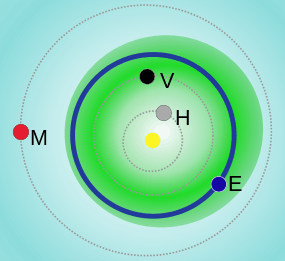2013 XY8
| Discovery[1] | |
|---|---|
| Discovered by | Catalina Sky Survey |
| Discovery site | Summerhaven, Arizona, USA |
| Discovery date | December 7, 2013 |
| Designations | |
| MPC designation | 2013 XY8 |
| MPO 307077 | |
Apollo  NEO | |
| Orbital characteristics[2] | |
| Epoch 4 September 2017 (JD 2458000.5) | |
| Uncertainty parameter 2[1] | |
| Observation arc | 6[1] d |
| Aphelion | 3.46240 AU (517.968 Gm) |
| Perihelion | 0.95250 AU (142.492 Gm) |
| 2.20745 AU (330.230 Gm) | |
| Eccentricity | 0.56851 |
|
3.28 yr (1197.94 d) 3.28 yr | |
| 43.430° | |
| 0° 18m 1.944s /day | |
| Inclination | 1.81202° |
| 80.9083° | |
| 25.004° | |
| Earth MOID | 0.000538513 AU (80,560.4 km)[2] |
| Mercury MOID | 0.63716 AU (95,318,000 km)[1] |
| Jupiter MOID | 1.71473 AU (256.520 Gm)[2] |
| Physical characteristics | |
Sidereal rotation period | 0.06055 hr[2] |
| 25.0[2] | |
|
| |
2013 XY8 is a near-Earth Apollo asteroid that passed 0.00508 AU (760,000 km; 472,000 mi) from Earth on December 11, 2013.[2][3] It pass by Earth at about 2 lunar distances, but was discovered just 5 days previous, on December 7, 2013.[3] At 30–70 metres (98–230 feet) across it is bigger than the Chelyabinsk meteor.[3] 2013 XY8 has been observed by radar and has a well determined orbit.[2] It will pass about 0.0007 AU (100,000 km; 65,000 mi) from the Moon on 11 December 2095.[2] It was imaged by the Faulkes Telescope South.[3]
It was described as being about the size of the Space Shuttle and was reported to be traveling at 14 kilometers per second (over 31 thousand miles per hour) relative to the Earth.[4]
References
- 1 2 3 4 "2013 XY8". Minor Planet Center. Retrieved 16 August 2017.
- 1 2 3 4 5 6 7 8 "(2013 XY8)". JPL Small-Body Database. Jet Propulsion Laboratory. SPK-ID: 3654382. Retrieved 16 August 2017.
- 1 2 3 4 Asteroid 2013 XY8 Tumbled By Earth Today - Slate
- ↑ "Space Shuttle-Sized Asteroid 2013 XY8 to Fly Past Earth on Dec. 11 | The Spaceguard Centre". spaceguardcentre.com. Retrieved 2018-01-24.
See also
External links
This article is issued from
Wikipedia.
The text is licensed under Creative Commons - Attribution - Sharealike.
Additional terms may apply for the media files.


